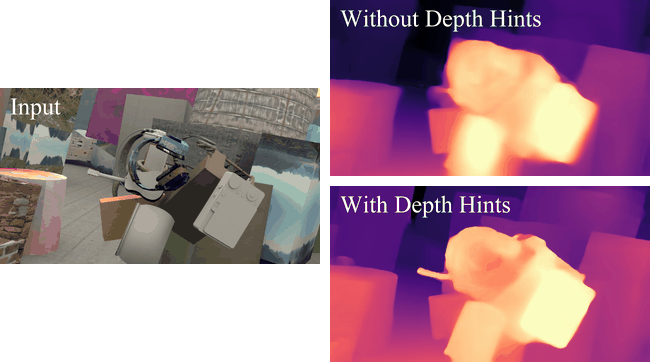Jamie Watson, Michael Firman, Gabriel J. Brostow and Daniyar Turmukhambetov – ICCV 2019
We introduce Depth Hints, which improve monocular depth estimation algorithms trained from stereo pairs.
We find that photometric reprojection losses used with self-supervised learning typically have multiple local minima.
This can restrict what a regression network learns, for example causing artifacts around thin structures.
Depth Hints are complementary depth suggestions obtained from simple off-the-shelf stereo algorithms, e.g. Semi-Global Matching. These hints are used during training to guide the network to learn better weights. They require no additional data, and are assumed to be right only sometimes.
Combined with other good practices, Depth Hints gives state-of-the-art depth predictions on the KITTI benchmark (see images above and results table below). We show additional monocular depth estimation results on the sceneflow dataset:
If you find our work useful or interesting, please consider citing our paper:
@inproceedings{watson-2019-depth-hints,
title = {Self-Supervised Monocular Depth Hints},
author = {Jamie Watson and
Michael Firman and
Gabriel J. Brostow and
Daniyar Turmukhambetov},
booktitle = {The International Conference on Computer Vision (ICCV)},
month = {October},
year = {2019}
}
| Model name | Training modality | ImageNet pretrained | Resolution | Abs rel | Sq rel | 𝛿 < 1.25 |
|---|---|---|---|---|---|---|
Ours Resnet50 |
Stereo | Yes | 640 x 192 | 0.102 | 0.762 | 0.880 |
Ours Resnet50 no pt |
Stereo | No | 640 x 192 | 0.118 | 0.941 | 0.850 |
Ours HR Resnet50 |
Stereo | Yes | 1024 x 320 | 0.096 | 0.710 | 0.890 |
Ours HR Resnet50 no pt |
Stereo | No | 1024 x 320 | 0.112 | 0.857 | 0.861 |
Ours HR |
Mono + Stereo | Yes | 1024 x 320 | 0.098 | 0.702 | 0.887 |
Please see the paper for full results. To download the weights and predictions for each model please follow the links below:
| Model name | Training modality | ImageNet pretrained | Resolution | Weights | Eigen Predictions |
|---|---|---|---|---|---|
Ours Resnet50 |
Stereo | Yes | 640 x 192 | Download | Download |
Ours Resnet50 no pt |
Stereo | No | 640 x 192 | Download | Download |
Ours HR Resnet50 |
Stereo | Yes | 1024 x 320 | Download | Download |
Ours HR Resnet50 no pt |
Stereo | No | 1024 x 320 | Download | Download |
Ours HR |
Mono + Stereo | Yes | 1024 x 320 | Download | Download |
The code for Depth Hints builds upon monodepth2. If you have questions about running the code, please see the issues in that repository first.
To train using depth hints:
- Clone this repository
- Run
python precompute_depth_hints.py --data_path <your_KITTI_path>, optionally setting--save_path(will default to <data_path>/depth_hints) and--filenames(will default to training and validation images for the eigen split). This will create the "fused" depth hints referenced in the paper. This process takes approximately 4 hours on a GPU. - Add the flag
--use_depth_hintsto your usual monodepth2 training command, optionally also setting--depth_hint_path(will default to <data_path>/depth_hints). See below for a full command.
🎉 And that's it! 🎉
To recreate the results from our paper, run:
python train.py
--data_path <your_KITTI_path>
--log_dir <your_save_path>
--model_name stereo_depth_hints
--use_depth_hints
--depth_hint_path <your_depth_hint_path>
--frame_ids 0 --use_stereo
--scheduler_step_size 5
--split eigen_full
--disparity_smoothness 0
Additionally:
- For Resnet50 models, add
--num_layers 50 - Add
--height 320 --width 1024for High Resolution models (you may also have to set--batch_size 6depending on the size of your GPU) - For Mono + Stereo add
--frame_ids 0 -1 1and remove--split eigen_full
The results above and in the main paper arise from evaluating on the KITTI sparse LiDAR point cloud, using the Eigen Test split.
To test on KITTI, run:
python evaluate_depth.py
--data_path <your_KITTI_path>
--load_weights_folder <your_model_path>
--use_stereo
Make sure you have run export_gt_depth.py to extract ground truth files.
Additionally, if you see ValueError: Object arrays cannot be loaded when allow_pickle=False, then either downgrade numpy, or change line 166 in evaluate_depth.py to
gt_depths = np.load(gt_path, fix_imports=True, encoding='latin1', allow_pickle=True)["data"]
To run on your own images, run:
python test_simple.py
--image_path <your_image_path>
--model_path <your_model_path>
--num_layers <18 or 50>
This will save a numpy array of depths, and a colormapped depth image.
Copyright © Niantic, Inc. 2020. Patent Pending. All rights reserved. Please see the license file for terms.

